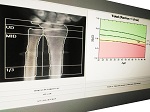
One in two women will break a bone in their lifetime. For some, the bones become so porous as they age that even a sneeze can fracture a bone. But what if bone loss is not inevitable? In a surprising discovery, researchers were able to increase the bone mass of female mice by eight hundred percent through targeting the hormone, estrogen.
In the blood, estrogen regulates sexual development, plays a role in the heart, breasts, skin and hair, as well as bone development. But we're not sure of its role in the brain. Researchers wanted to see how estrogen-sensitive nerve cells in the brain's hypothalamus affect metabolism.
The hypothalamus links the nervous system to the endocrine system, where hormones are made. Together they regulate essential bodily functions such as sex drive and heart rate. To see how estrogen impacts this system, scientists blocked the receptors for estrogen in the hypothalamus and saw that the mice gained weight.
They thought it was fat or muscle, but they were amazed to find the weight was bone mass. Not only had it grown by eight hundred percent, the bones became super strong. Researchers then focused on a region of the hypothalamus called the arcuate nucleus. When they blocked the estrogen receptors here in mice with bone density loss of seventy percent, half of it returned in just weeks.
The theory is that after puberty, estrogen in the hypothalamus tells the body to divert energy away from bone growth to reproduction. The estrogen blocked mice were able to maintain their bone density through old age, so this offers an exciting path for scientists to explore. This brain to bone signaling pathway may be key to allowing women to keep their bone strength well into old age.
More Information
Osteoporosis breakthrough: Bone mass increased by 800 percent
A groundbreaking set of studies has found that blocking certain receptors in the brain leads to the growth of remarkably strong bones. Could a new osteoporosis treatment be on the horizon?...
Estrogen signaling in arcuate Kiss1 neurons suppresses a sex-dependent female circuit promoting dense strong bones
We propose that a newly-identified female brain-to-bone pathway exists as a homeostatic regulator diverting calcium and energy stores from bone building when energetic demands are high. Our work reveals a previously unknown target for treatment of age-related bone disease...
National Osteoporosis Foundation Osteoporosis Fast Facts
Osteoporosis is a disease of the bone that makes a person's bones weak and more likely to break. Approximately 10 million Americans have osteoporosis and another 44 million have low bone density, placing them at increased risk..